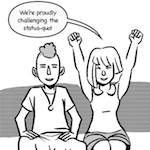…That You Need to Know About
If you’re anything like the white, young, heterosexual, cis-gendered couple couple who open Joamette Gil’s comic on radical forms of non-monogamy, you might think that simply opening up your relationship to threesomes really challenges the status quo. But does it? Or do those actions in some ways actually reinforce mainstream stereotypes, without taking into account other, less privileged relationship models? Do you see your own relationship privilege?
Read all of the comic here at Everyday Feminism, and see if your perspective broadens any.



OK, so this is cool. And…I’ve been having the nonmonogamy discussion as a public presenter for 19 years and here is my observation after many many conversations: these descriptions seem incredibly complex.
They are also contorting poly to include genderqueer. I think we might start with something more straightforward, like the relationship between bisexuality and polyamory.
The genderqueer “community” overestimates the extent to which people get what they’re doing. What seems to be “normal” for them can seem incomprehensible to many other people, who are not even up to admitting they might want to spend the occasional night without their partner, and without anyone else either.
These models are also extremely other-centered and don’t account for the primacy of one’s relationship with oneself.
How is it a contortion of poly (a relationship-style) to include gender queer (a gender identity)? Just curious 🙂
I hope Eric will answer your question, because I think it’s a very valid one.
These descriptions seem incredibly complex? Eric, to me they seem almost incomprehensible. Makes me almost glad that, at 16 years of age and in view of the illegality of homosexuality in Britain at that time, I made the decision that the intelligent response was to be celibate.
Amanda — I would like to develop a style rule on cis gendered. I don’t like this term — I was astonished and actually appalled that it exists. My proposed rule is that cis gendered be used only when people refer to themselves, similar to queer. It’s rare enough that we use it and it’s only going to turn up in my language when I am deconstructing it. I don’t find it helpful and I notice that it’s often used as a pejorative term (“these middle-aged cis gendered men are ruining our sex parties”), though this is subtle. However, apart from that we need to decide what definition really applies — “identifies with birth gender” or “has not questioned birth gender.”
What is ‘cis’ gendered? First time hearing that.
jasonboyd: Following a quick peak between your legs at the moment of birth you will have been assigned a gender – either male or female (although there may be occasions when this is not entirely clear-cut as in the case of intersex people). Medically, gender can be determined from about the 12th week of pregnancy; prenatal sex discernment can also be performed before conception if your parents insist on determining the gender of their child.
Cisgender is a recently-invented term defined by the Oxford English Dictionary as “a person whose sense of personal identity corresponds to the sex and gender assigned to him or her at birth (in contrast with transgender).” The word covers both males and females. Other terms used are “non-trans” or “gender normative.”
There is some debate about the use of cisgender. Non-trans is considered to be clearer for the average person to understand. Others see it as unhelpful because it puts gays, lesbians and bisexuals in the same group as heteronormative people rather than with transgender people. Lesbians and homosexuals are usually cisgender. The criterion is simply whether you identify with your assigned gender, not which gender you might prefer to have sex with.
Basically, if you identify with and are happy with your assigned gender then you are cisgender. If though, for example, you feel that you are a man in a woman’s body or a woman in a man’s body then you are transgender.
Hope that helps.
Thanks Geoff for your explanation. It is helpful. The prefix ‘cis’ still escapes my understanding. I’ll look at the dictionary for a clue:-)
Ha-ha! It was the one thing I thought I should have included after I pressed ‘post comment’.
If anyone else is curious and hasn’t looked it up yet, cis is the Latin prefix for “on this side of” as opposed to trans which is “on the other side of.”
I must say I would find the phrase “Oh, (s)he’s on this side of gender” a rather camp way of describing people who are gender normative.
Nice, thanks Geoff for posting. I found same on wikipedia:-)
Cheers, Jason. I’ve developed a great respect for the universal library that wiki has become and use it with confidence to check facts and bolster my fading memory. I thought of just sending you the link but decided instead to confirm and reinforce my understanding of this concept. Thank you for giving me the opportunity to do so.
Geoff Marsh, I once was involved with a male who had a dick the (in aroused state) the size of my little finger. I felt really bad for him. I have wondered since whether he was a she at birth but forced to be he.
I can’t answer that one, I’m afraid, Cowboyiam.